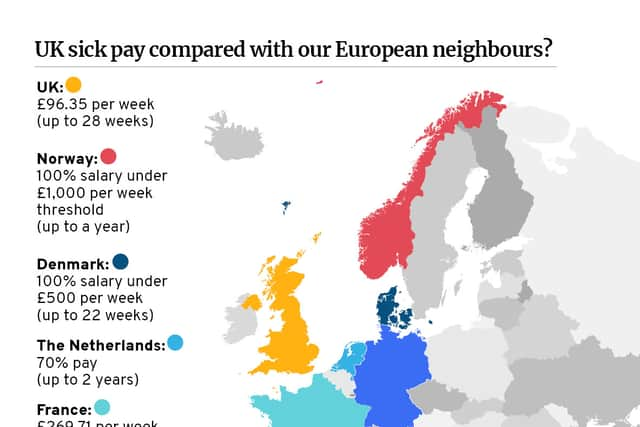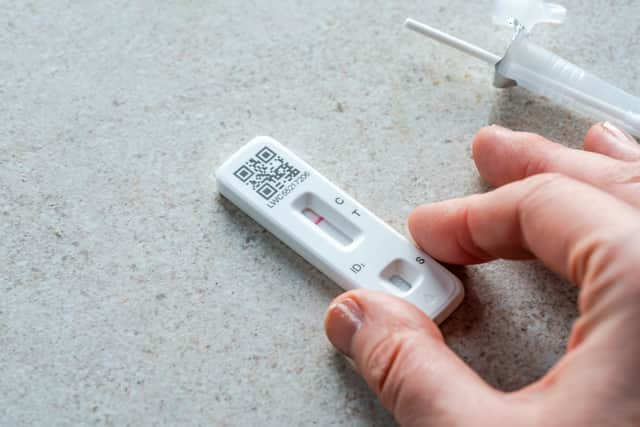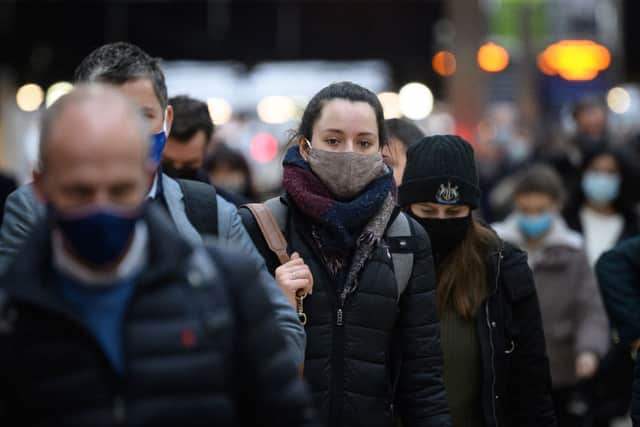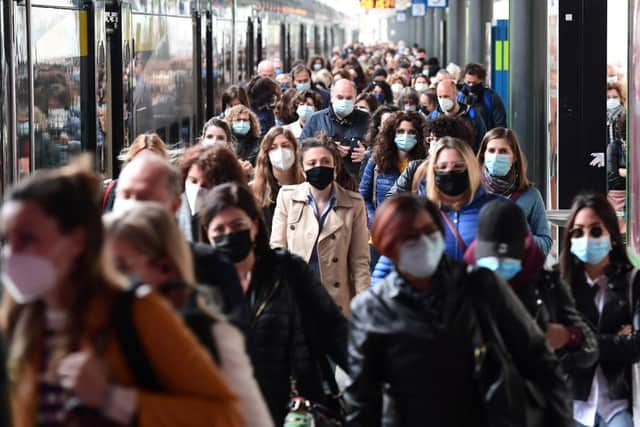How much is statutory sick pay? Covid rule changes explained and what is UK SSP compared to Germany and France
This article contains affiliate links. We may earn a small commission on items purchased through this article, but that does not affect our editorial judgement.
and live on Freeview channel 276
UK statutory sick pay (SSP) has changed for people with Covid in England as part of Boris Johnson‘s ‘living with Covid’ strategy.
The policy was announced in February alongside the move to scrap self-isolation rules for positive Covid cases.
Advertisement
Hide AdAdvertisement
Hide AdFree Covid testing is also set to end for people in England from next Friday (1 April).
First day statutory sick pay for people with Covid-19 was first brought in by the Government in March 2020 to help contain the spread of the virus.
So what is UK statutory sick pay, how’s it changing - and how does it compare with other major economies?


How much is UK statutory sick pay?
If you’re too ill to work, you’re entitled to receive statutory sick pay (SSP) from your employer.
Advertisement
Hide AdAdvertisement
Hide AdMore than 7.8 million workers rely on this kind of sick pay.
SSP is paid in exactly the same way as your regular wage, so either weekly or monthly, with tax and national insurance deductions taken from it.
It provides workers with £96.35 per week for up to 28 weeks and typically kicks in from day four of an employee’s illness.


In most instances, the first three days of sick leave are considered to be a ‘waiting’ period and go unpaid.
Advertisement
Hide AdAdvertisement
Hide AdDuring the Covid pandemic, those who tested positive for the virus or had to self-isolate because they were a close contact were paid SSP from day one - albeit if they had had to isolate for at least four days.
Employers often offer their own more generous schemes, but SSP is the baseline figure for every UK full-time employee.


If you’re self-employed, you are not eligible to receive SSP but can apply to receive state benefits.
For more detail on the rules around statutory sick pay, visit the Government website.
How has SSP changed for people with Covid?
Advertisement
Hide AdAdvertisement
Hide AdFirst day SSP for Covid cases will be scrapped and all SSP will move back to day four.
The Government always said the update to SSP was going to be temporary.
But it has been scrapped despite advice from the UK’s chief medical officer Professor Sir Chris Whitty that people should still self-isolate after a positive Covid-19 test.
This change kicked in on Thursday (24 March).
How does UK statutory sick pay compare?
The UK’s SSP of £96.35 per week - less than one sixth of the average median wage of £611 (as calculated by the ONS) - is one of the least generous in Europe.
Advertisement
Hide AdAdvertisement
Hide AdNationalWorld has compared the UK rate to those offered by major EU economies and our closest European neighbours.


Unless specified, the information below is based on the assumption that a full-time employee has worked for their employer for the period of time required to qualify for that country’s SSP and has met all the requirements to receive it.
Germany: You can be paid your full wage by your employer for the first six weeks of illness.
If you’re still unfit for work after this period and have a doctor’s note, state or private health insurance will pay you the equivalent of 70% of your last regular paypacket - but no more than 90% of your net earnings - for a maximum of 78 weeks.
Advertisement
Hide AdAdvertisement
Hide AdFrance: The minimum sick pay you are entitled to is 50% of the daily basic wage - €46 (£38.53) or €2,798.25 (£2343.72) gross per month.
It is generally paid out for up to a year and kicks in from day four of sick leave.
Italy: As in the UK, Italy has three ‘waiting’ days before SSP is given out.
Once this threshold has been met, you will receive SSP from your employer that’s generally equivalent to 50% of your average daily pay between the fourth and twentieth day of your sick leave
Advertisement
Hide AdAdvertisement
Hide AdIt rises to 66.66% of your daily pay between day 21 and day 180 of your illness.
SSP ends after 180 days (more than 25 weeks) in a calendar year.


Spain: What you get depends on how often and how much you contribute towards social security - this is known as your ‘calculation basis’.
So if you are paid monthly, it’s the amount divided by 30.
From day four to day 20 of your sick leave, you are given 60% of the calculation basis regardless of whether your are an employee or self-employed.
And from day 21, this rises to 75%.
Advertisement
Hide AdAdvertisement
Hide AdYou can get these benefits for a maximum of a calendar year.
This can be extended for another 180 days if it’s believed you’ll recover during this period.
The Netherlands: Your employer is required by law to give you at least 70% of your pay for a two year period.
If you are classed as a ‘temporary’ employee or receive unemployment benefit, the state pays you the equivalent of 70% of the average daily pay you received before your sick leave.
Advertisement
Hide AdAdvertisement
Hide AdWhen you are paid by the state, you get a maximum of €223.40 (£187) per day, with the level of your benefit determined by your last official earned pay packet.
Denmark: Generally, SSP is paid out for a maximum of 22 weeks in a nine month period.
It’s calculated on the basis of how many hours you’re contracted to work a week and the average hourly pay you have received for the three months prior to your sick leave.
SSP is capped at DKK 4,460 (£500) per week, or DKK 120.54 (£13.56) per hour.
Advertisement
Hide AdAdvertisement
Hide AdFor part-time workers, the amount of benefit is calculated on the basis of the number of hours of work you do in an average working day and your current hourly income.
It is also capped at DKK 120.54 (£13.56) per hour.
After 30 days, payments will be made by your local authority instead of your employer.
Norway: The first 16 days of your sick leave are paid by your employer and will total your average salary from the last three calendar months in the run up to your first day off sick.
This average income is converted into an annual income that’s paid by the state after 16 days, and can be paid out for up to a year.
Advertisement
Hide AdAdvertisement
Hide AdIt cannot exceed six-times the ‘basic amount’ - an amount of money used to calculate benefits and pensions, that gets set each year on 1 May.
At current levels, this means you cannot earn more than NOK 608 106 (£50,426.10) a year or more than NOK £50,675 (£4,202.13) a month.
A message from the editor:
Thank you for reading. NationalWorld is a new national news brand, produced by a team of journalists, editors, video producers and designers who live and work across the UK. Find out more about who’s who in the team, and our editorial values. We want to start a community among our readers, so please follow us on Facebook, Twitter and Instagram, and keep the conversation going. You can also sign up to our email newsletters and get a curated selection of our best reads to your inbox every day.
Comment Guidelines
National World encourages reader discussion on our stories. User feedback, insights and back-and-forth exchanges add a rich layer of context to reporting. Please review our Community Guidelines before commenting.
